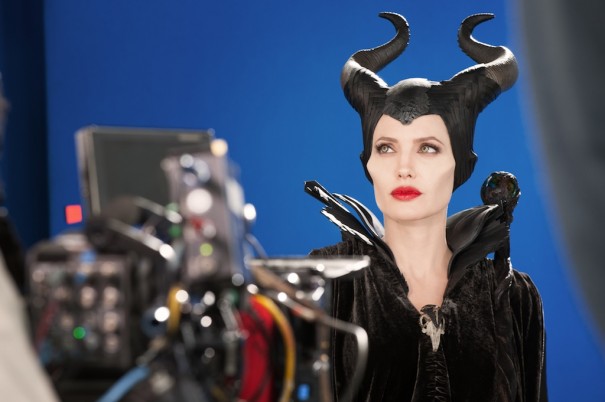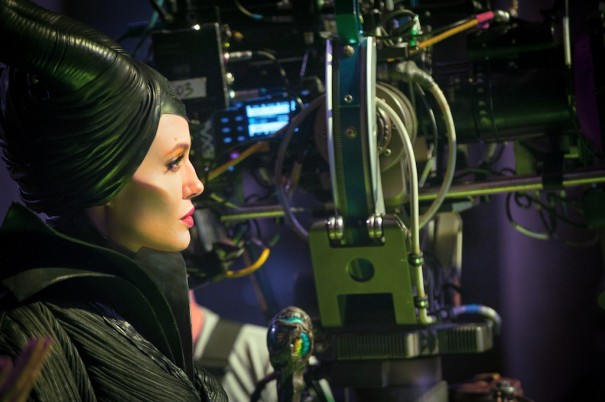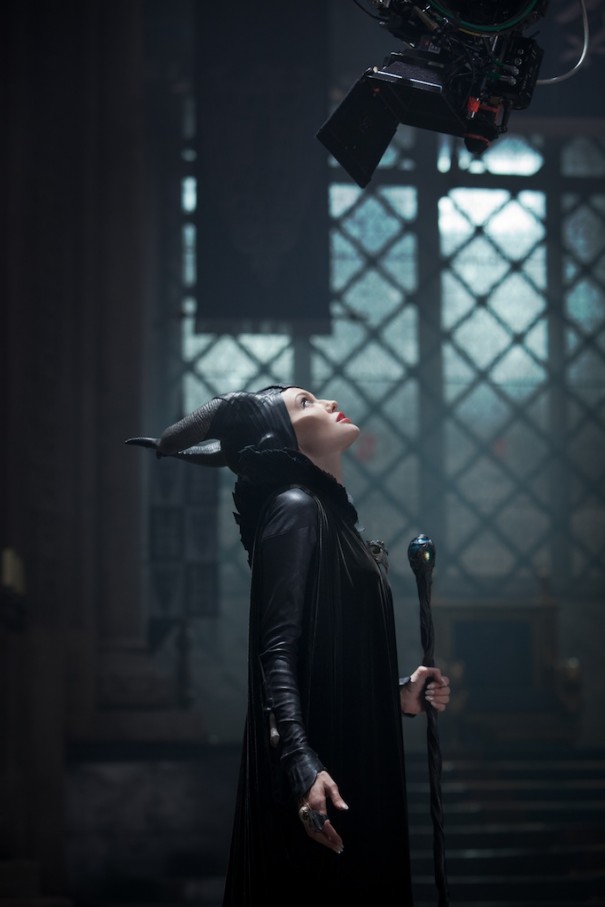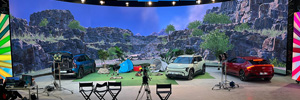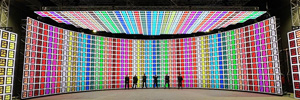Maléfica, la bruja por excelencia de Disney, cobra vida en la gran pantalla
Rodada con las cámaras ARRI Alexa Plus y Studio, con lentes Panavision Primo, y trabajando en un formato ARRIRAW (2,8K), Disney estrena la adaptación a la gran pantalla de la villana del clásico de 1959 ‘La Bella Durmiente’.
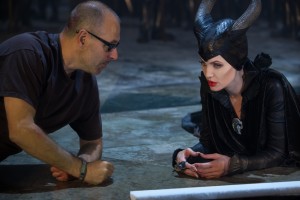 Disney estrena este fin de semana en todo el mundo, Maléfica, la adaptación a la gran pantalla de la villana del clásico de 1959 La Bella Durmiente.
Disney estrena este fin de semana en todo el mundo, Maléfica, la adaptación a la gran pantalla de la villana del clásico de 1959 La Bella Durmiente.
Maléfica es una bellísima joven con un corazón puro y unas asombrosas alas negras. Crece en un entorno idílico, un apacible reino en el bosque, hasta que un día un ejército de invasores humanos amenaza la armonía del país. Maléfica se erige en la temible protectora de su reino, pero al final es objeto de una despiadada traición que endurecerá su corazón hasta convertirlo en piedra. Cegada por sus ansias de venganza, Maléfica libra una batalla épica con el rey de los humanos y como resultado lanza una maldición sobre Aurora, su hija recién nacida. Cuando la niña crece, comprende que Aurora tiene la llave de la paz en el reino, y también de la verdadera felicidad de Maléfica.
La película está interpretada por Angelina Jolie en el papel de Maléfica, Sharlto Copley, Elle Fanning, Sam Riley, Imelda Staunton, Juno Temple y Lesley Manville.
La película está producida por Joe Roth y dirigida por Robert Stromberg, con Angelina Jolie, Don Hahn, Matt Smith, Palak Patel, Sarah Bradshaw y Michael Vieira como productores ejecutivos. Linda Woolverton escribió el guión.
Curiosidades del rodaje
Maléfica se ha rodado con las cámaras ARRI Alexa Plus y Studio, con lentes Panavision Primo, trabajando en un formato ARRIRAW (2,8K). EFilm se encargó de la intermediacion digital, mientras que la tecnología de Codex jugó un papel destacado en todo el workflow.
La producción contó con un número extraordinario de sets físicos. Los diseñadores de producción Gary Freeman y Dylan Cole, junto con el decorador de plató Lee Sandales, trabajaron con Stromberg para crear fondos exteriores e interiores a la altura de esta gran epopeya. Se construyeron cerca de 40 platós, desde una habitación de 1,10 m2, al Gran Salón de 460 m2.
El castillo es una recreación física, tanto en su interior como en su exterior, del castillo de la película animada de 1959. Es grandioso, con suelos de mármol y materiales y acabados del siglo XVI y está amueblado con antigüedades. Se tardó 14 semanas en construir, empleando 250 operarios, y un departamento artístico de 20 personas.
Ricky Baker, ganador de siete Oscar, dirigió el departamento de efectos especiales de maquillaje. Se encargó de los cuernos y las prótesis de pómulos de Angelina Jolie así como de otros maquillajes especiales de personajes. Baker y su equipo esculpieron tres juegos diferentes de cuernos basándose en el look original de Maléfica en la película animada. Los cuernos están fabricados con una resina de uretano, un material ligero y duradero. Para que todas las prótesis de Angelina Jolie encajaran con los ángulos de su rostro, el equipo hizo un molde de su cabeza y elaboró mejillas y orejas de goma siguiendo esos contornos. En el caso de Angelina Jolie, se invertían cuatro horas diarias en colocarle la prótesis.
En la producción se utilizó la técnica de captura de movimiento para las tres Hadas (Imelda Staunton, Juno Temple y Lesley Manville) cuando se filmaron en su tamaño original de 53 cm para captar todos los matices del talento de las tres actrices. El equipo de efectos visuales utilizó 150 marcadores en cada una de las caras para reproducir sus expresiones faciales en los personajes generados por ordenador. Estos divertidos personajes se caricaturizaron ligeramente en el tamaño de 53 cm, con cabezas más grandes y se exageraron sus siluetas naturales para que no parecieran personas normales reducidas a 53 cm de altura.
Conseguir el look perfecto para la película de acción real era muy importante tanto para el director Robert Stromberg como para Angelina Jolie. “A Angelina no sólo le fascinaba el personaje sino también su aspecto”, dice Stromberg. “Trabajamos juntos para conseguir un personaje que no fuera una imagen estereotipada, pero también era imprescindible que el público reconociera inmediatamente a Maléfica”.
El trabajo de recrear el traje de Maléfica a partir de la película animada recayó en la diseñadora de vestuario Anna B. Sheppard, conocida por su trabajo en “La lista de Schindler” y “El pianista”, que le valieron sendas nominaciones a los Premios de la Academia. La diseñadora de vestuario tenía que crear dos mundos muy diferentes, uno con criaturas que viven en un bosque de hadas y otro que es un reino humano. Sheppard empezó sus investigaciones estudiando el siglo XV, el arte renacentista francés e italiano en cuadros, bocetos y esculturas.
El look del personaje de Maléfica que aparecía en la película animada de 1959 fue obra del animador Marc Davis, al que debemos los cuernos de Maléfica y su estilo elegante con capas fluidas y gargantillas altas. Así que Sheppard empezó con estas referencias para encontrar el aspecto de Maléfica. Después de ver “La Bella Durmiente”, Sheppard añadió los elementos de diseño y afirma: “El personaje que procede de esa película es Maléfica. Utilicé colores que se parecen a la película de Disney. Creo que en la gran escena del bautismo, el aspecto de Maléfica es el que todo el mundo espera. Es la Maléfica de la versión animada, sólo que mucho más hermosa”.
La diseñadora de vestuario señala: “Los trajes de Maléfica evolucionan y pasan de las tonalidades verde musgo y los tejidos “etéreos” a los colores oscuros y las formas esculturales con tejidos mucho más pesados con muchísimo volumen. Las pieles artificiales y los accesorios de plumas que crearon diseñadores especializados se utilizaron para darle un aspecto mucho más oscuro y siniestro al personaje”.
Uno de los primeros elementos que se crearon fueron los cuernos y el contorno facial de Maléfica ya que eran imprescindibles para crear el estilo distintivo de Maléfica. Rick Baker, el diseñador de efectos especiales de maquillaje, ganador de siete Oscar®, se incorporó a este proceso. Baker empezó inmediatamente con un cuadro digital en el que reprodujo su visión del look de Maléfica. “Pensé en Angelina Jolie, y no quería recargarla demasiado. En mi opinión había que añadir cuernos y orejas y no hacerle nada en la cara”, dice Baker.
Pero el diseño sufrió ciertas transformaciones con las ideas que aportó Angelina Jolie. Tal y como explica Baker: “Angelina quería llevar prótesis, así que hice algunos diseños con prótesis que resultaran sutiles. También quería una nariz que reforzara el look de Maléfica. En las fases iniciales, creamos muchas combinaciones de mejillas, orejas y cuernos. Primero realizamos bocetos y después los esculpimos en un molde de su cabeza e hicimos prototipos para que los revisara”.
Baker creó para Jolie prótesis de mejillas, narices y orejas de silicona y rellenas de gel. En la película, las mejillas de Maléfica están muy marcadas, pero lo cierto es que las prótesis son muy pequeñas. Baker lo explica: “Es increíble porque el máximo grosor de las prótesis es de 6,35 mm y 1,27 cm de ancho. Están colocadas en la parte más prominente de sus pómulos”.
Cuando llegó la hora de hacer los cuernos, Baker se enfrentó a varios retos. “Los cuernos plantearon el mayor problema porque a nadie le apetece pasarse el día con unos cuernos enormes en la cabeza”, cuenta Baker. “Así que quería que fueran lo más ligeros posible y también desmontables porque cuando llevas un objeto en la cabeza que sobresale 30 cm y no estás acostumbrado, seguro que te pasas el día chocándote con las cosas”.
Baker y su equipo esculpieron un mínimo de cuatro diseños diferentes de cuernos. “Hice algunos dibujos y también moldeé diseños de cuernos en el ordenador”, dice Baker. “Después los esculpimos. Escogimos el que nos gustó más e hicimos todo el trabajo basándonos en ese único diseño”.
Lo bueno es que los cuernos son muy ligeros y finos y están fabricados con una resina de uretano. “Después de experimentar mucho acabamos con un casquete grande que llevaba incorporada la base de los cuernos y los 2,5 primeros centímetros de los cuernos”, explica Baker. “El resto de los cuernos se unía con un imán. Eran imanes muy fuertes que los sujetaban perfectamente y que nos permitían quitarlos cuando no se rodaba”.
La piel verde que tiene Maléfica en “La Bella Durmiente” no existe en la versión de acción real de “Maléfica”. “Pero queríamos que fuera guapa y atractiva”, apunta Baker. “Era muy importante porque no deseábamos que pareciera una criatura de ficción. Queríamos que en esta película su aspecto fuera lo más realista posible”.
Baker también utilizó lentillas para completar el look de la Maléfica de Jolie. “Angelina las diseñó”, dice Baker. “Una artista experta en ese campo pintó a mano las lentillas. Trabajo con una persona que las hace siempre para nosotros. Teníamos algunas fotos de los ojos y los hicimos un poco más grandes”.
Después de diseñar y elaborar los cuernos, el sombrerero Justin Smith se incorporó al diseño para forrar los cuernos y el tocado que lleva la Maléfica de Jolie. Lo primero que hizo fue estudiar los trajes que había creado Anna Sheppard para el personaje. Después aportó sus ideas innovadoras a la creación de un look emblemático basado en el personaje original de la película animada. Al explicar sus ideas, Smith comenta: “Angelina siempre fue la musa y creé para ellas varios diseños de tocados. Los diseños estaban basados en la historia de Maléfica, es decir en el hecho de que tiene cuernos. Diseñé y creé looks que reflejaran la tensión entre el terror que inspira y el elemento mágico. El resultado fue una versión contemporánea de alta costura de la versión animada de los años 50”.
Smith consultó con Angelina Jolie, la estrella de la película, para elaborar el diseño básico de los tocados. “Angelina quería algo que le cubriera totalmente la cabeza y le tapara todo el pelo. Pero no quería que pareciera que llevaba un turbante en la cabeza. Así que comprendí enseguida lo que quería y empezamos a crear una identidad para ella. Empezamos trabajando con pieles exóticas.
“Hay piel de pitón, cuero muy fino y también piel de pescado. Todo está basado en siluetas limpias y sencillas y en una técnica que permite colocarlas fácilmente envolviéndolas alrededor de la cabeza”, concluye Smith.
Para crear sus diseños, Smith partió de referencias ya existentes. “Está claro que hay un tema sobre el que teníamos que basarnos y contar con las telas que ya se habían escogido”, dice Smith. “Así que examiné los materiales que podía utilizar para que encajaran con el resto del vestuario. Aporté mis propias técnicas y el estilo moderno de sombrerería que me caracteriza. Muchas de mis referencias son artistas como Michael Parkes, que es uno de mis favoritos, sobre todo sus bellísimas litografías tan elegantes. También recabé información en algunos libros sobre nudos y otros que suelo utilizar para mi trabajo”.
Valiéndose de todos estos recursos, Smith adaptó sus técnicas y sus ideas al vestuario. “Intenté hacer algo que espero que resulte nuevo y algo vanguardista, con un toque futurista. Pero no quería que diera miedo ni que acaparara demasiado la atención”, explica Smith. “Se trata más bien de complementar el look general para que todo resulte armonioso”.
Smith se sirvió de la historia para guiarse, utilizando sus numerosas referencias a animales y criaturas del reino del bosque y aportó algunas influencias del reino animal al look de Maléfica. “La idea era que los tocados no tuvieran ninguna estructura, sin ninguna costura”, explica el sombrerero. “Parecen muy artesanales, como si fueran pieles y materiales provenientes del bosque. Es como si Maléfica se hubiera envuelto con ellos la cabeza. La idea era que parecieran muy naturales y nada artificiosos”.
Smith creó seis tocados diferentes que corresponden a las estaciones a escenas concretas. Al describir algunos de los looks, Smith afirma: “Hay un look de verano que es un tocado de piel de pitón. En el bautizo lleva un turbante de cuero con espinas forradas de cuero. También tenemos un look de primavera que es una cinta de cuero cosido que crea un efecto estriado y que luego se pintó y se lacó. Está el tocado de raya con púas. La raya está en la parte superior y el cuero a los lados”.
[youtube]https://www.youtube.com/watch?v=guZJMgCatiM[/youtube]
Did you like this article?
Subscribe to us RSS feed And you will not miss anything.



